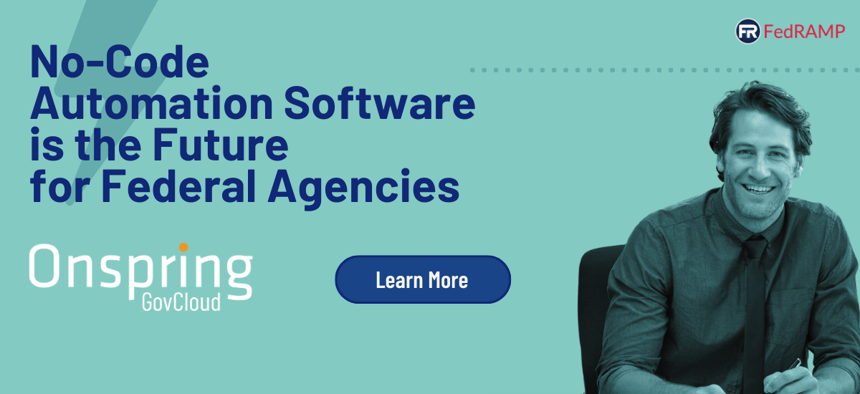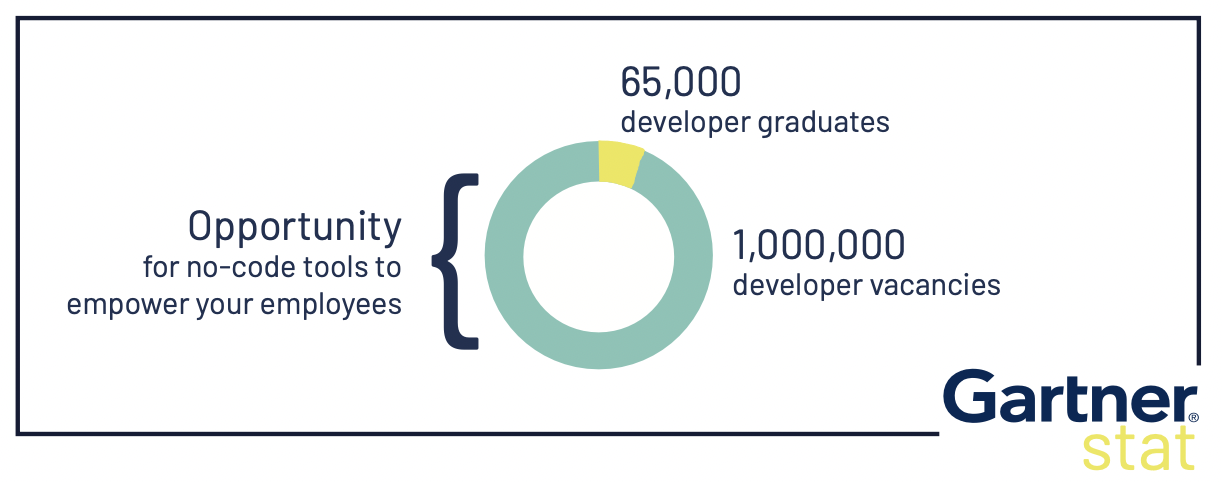sponsor content What's this?
No-Code Automation Software is the Future for Federal Agencies

Presented by
Onspring

Take control of risk management processes with the most advanced, easy-to-use GRC software.
It’s no secret that we’ve entered a world of accelerated digital transformation.
The vast innovation and possibilities are exciting for many, but some dread the burden it will cause on their IT resources. With modernization efforts driving federal agencies to adopt cloud-based technology, leadership is looking to create efficiencies and enable better collaborations that don't break the bank or overwhelm burdened teams.
Here we'll take you through the increase in demand for cloud-based no-code technology, including how this software works and how it helps federal agencies.
One crucial innovation to help federal agencies make risk-based decisions is no-code GRC software rooted in flexibility.
So what does "no code" mean?
No-code automation is an approach to software that empowers end-users to self-service configurations without the need of an IT resource to make updates through code changes.
Think of the task tracker you use for work or maybe the personal blog you’re building for your personal site—those are most likely no-code platforms. But what about tools for more complicated tasks such as governance, risk, and compliance (GRC) processes? These typically required IT intervention to help implement the proper system or platform—until now.
No-code software gives the users the opportunity to implement quickly and with configurations they make on their own with simple drag-and-drop functionality.
According to Gartner research, demand for digital transformation and automation has increased tremendously and can no longer be met by just an organization’s IT department.1 Additionally, there are over 1 million software developer vacancies at American organizations, with only 65,000 developers graduating from college every year—creating a major labor shortage.2 The answer to this increased demand for digital tools and low supply of IT developers/engineers is no-code software.

Why the Future is No Code
Not only are these tools beneficial for freeing up the IT department for more strategic technology projects, but they also have a lot of positive effects for government workers and federal agencies as a whole.
Top 4 benefits of using no-code software:
- Speed to Launch Software
- Efficiency Delivering on Process Configurations & Reporting
- Reduce Costs by Eliminating the Need for Funding IT Resources
- Teams & Processes Achieve True Agility
By 2025, spending on [non-developer required technologies] is expected to grow to almost $30 billion.3
The Benefits Explained
- Speed to Launch Software: By adopting no-code software, your team can deploy, configure, and update on its own, which means you don’t have to queue for support resources. The time to launch automated processes and reporting that enables risk-based decision making drops from months to weeks. According to Gartner’s research, there is “opportunity to scale technology production in responsive, agile, and innovative ways,” by shifting technology responsibility across team members. 60% of all organizations fail to execute on strategy because of IT resource gaps.4 No-code software delivers immediate control. With no-code tools, anyone at your agency has the skills to learn the basics of these applications.
- Efficiency Delivering on Process Configurations & Reporting: Improving employees’ technology literacy gives them more power and control over their daily tasks. When you’re in charge of no-code automation, you have control over what you’re managing, the cadence in which you track your processes, how exactly you’d like to manage your data, and why certain reports are shared with stakeholders over others. This, in turn, increases productivity, efficiency, and employee engagement. A recent Gartner study found that “when employees have a say in the design of their applications/solutions, they are more productive."5 That’s why Gartner projects a rise in non-developer-required technologies, giving rise to citizen developers–an employee who can create applications or implement platforms without the need for IT help.
- Reduce Costs by Eliminating the Need for Funding IT Resources: Manual application development or solutions implemented by engineers take time and require budget. Most teams do not have the financial resources or timeline to wait for these elements. No-code software is managed by end-users, not software developers, through simple drag-and-drop functionality. Budgets for IT teams are eliminated when cloud-based, no-code software is deployed because the end-users control the software experience, while the software vendor manages the security and up-time.
- Teams & Processes Achieve True Agility: By removing burdens around software updates, teams using no-code software gain the power to adjust workflows and reporting to fit current demands. Need intelligence on a business continuity plan in the next 30 seconds? Easily spun up in no-code software. Need to add a review step in the policy lifecycle process? Easily adjusted in no-code software. The speed in which teams can operate using no-code software is unprecedented. Processes are not only expedited, but tracked, and data is securely displayed in reporting on-the-fly.
The Future of Work is Here
Teams want to build technology solutions, manage datasets, and configure reports on-the-fly. Federal agencies are not only implementing this no-code software to combat a lack of resources, but they’re also helping teams reach their full potential.
- 73% of team members have technology literacy goals & ambitions.7
The right no-code software can solve your governance, risk, and compliance challenges
So, you might be thinking that the controls and flexibility of no-code software could benefit your agency immediately, but you need assistance transitioning off legacy software or away from spreadsheets.
If your agency is still using spreadsheets, you’re likely experiencing inconsistent data tracking and manual errors. Start documenting these occurrences and the length of time your team spends managing laborious, manual processes, or responding to risk findings and remediations. Use this data as benchmarks and communicate the results you expect above these benchmarks from any no-code software provider.
If your agency is using legacy software, your team is likely frustrated by the lack of autonomy and flexibility available in what you can adjust or manipulate. Start documenting the needs of your team to communicate your ‘dream state’ when it comes to process workflows and reporting. Bring that information to conversations with any no-code software vendor to share what you hope to accomplish with a software change.
It’s important to remember that no-code software vendors are not one-size fits all. Vet your options to ensure the right vendor can deliver on your needs and requirements.
If you've identified the need for a better approach to manage GRC, Onspring GovCloud might be the right no-code software for you.
Onspring GovCloud delivers real-time intelligence, workflow alignment, governance, and resilience to federal agencies.
While known for best-in-class GRC, POA&M, and OMB A-123 Risk & Control products, Onspring GovCloud empowers federal agencies with agility and flexibility through it's cloud-based, no-code software. The ability for teams to create workflows and reports that connect agency data and enable risk-based decision-making set Onspring GovCloud apart.
CONTACT:
Jonas Henkensiefken
Director, Federal Sales & Operations
(913) 433-0885
jonas.henkensiefken@onspring.com
1Nikos Drakos, Jason Wong, “Future of Work Trends: Tinkerers Become Mechanics,” Gartner, (2021).
2Keith Guttridge, Saikat Ray, Jason Wong, “Innovation Insight for Citizen Automation and Development Platforms,” Gartner, (2021).
3Laurie Wurster, Fabrizio Biscotti, Jason Wong, Paul Vincent,“Emerging Technologies: High-Velocity Demands Accelerate Low-Code Application Platforms,” Gartner, 2021.
4Nikos Drakos, Jason Wong, “Future of Work Trends: Tinkerers Become Mechanics,” Gartner, (2021).
5Keith Guttridge, Saikat Ray, Jason Wong, “Innovation Insight for Citizen Automation and Development Platforms,” Gartner, (2021).
6Ibid 7Keith Guttridge, Saikat Ray, Jason Wong, “Innovation Insight for Citizen Automation and Development Platforms,” Gartner, (2021).
8CIO Research Team, “Democratize and Distribute Technology Work Across the Entire Enterprise to Accelerate Digital Business,” Gartner, (2020).
This content is made possible by our sponsor Onspring; it is not written by and does not necessarily reflect the views of Nextgov/FCW’s editorial staff.
NEXT STORY: Fortifying cyber resilience: Peraton's data-centric approach to government security





